Rocky planet - Study guides, Class notes & Summaries
Looking for the best study guides, study notes and summaries about Rocky planet? On this page you'll find 187 study documents about Rocky planet.
Page 2 out of 187 results
Sort by
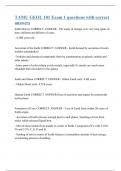
-
TAMU GEOL 101 Exam 1 questions with correct answers
- Exam (elaborations) • 20 pages • 2023
- Available in package deal
-
- $14.49
- + learn more
Earth History CORRECT ANSWER - The study of change over very long spans of time: millions and billions of years. - 4.56B years old Accretion of the Earth CORRECT ANSWER - Earth formed by accretion of rocky nodules (chondrules) - Nodules and chemical compounds form by condensation in galactic nebula and solar nebula - Inner parts of solar nebula is rich metals, especially Fe metals are much more abundant then elsewhere in the galaxy Earth and Moon CORRECT ANSWER - Oldest Earth rock: 4.4B...
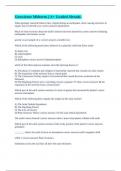
-
Geoscience Midterm || A+ Graded Already.
- Exam (elaborations) • 12 pages • 2024
-
Available in package deal
-
- $11.59
- + learn more
When geologic material behaves like a liquid during an earthquake, often causing structures to topple, this is referred to as correct answers liquefaction Much of what we know about the earth's interior has been learned by correct answers Studying earthquakes and seismic waves gravity is an example of a: correct answers scientific law Which of the following earth layers behaves as a plasticky solid that flows easily A) inner core B) asthenosphere C) crust D) lithosphere correct ...
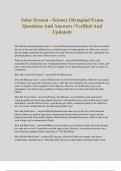
-
Solar System - Science Olympiad Exam Questions And Answers (Verified And Updated)
- Exam (elaborations) • 13 pages • 2024
- Available in package deal
-
- $12.49
- + learn more
Solar System - Science Olympiad Exam Questions And Answers (Verified And Updated) How did the terrestrial planets form? - answerIn the proto-Solar-Sytem, after the sun formed, the rest of the materials orbiting close around it began to clump together too. However, closer to the sun, lighter materials like gases blew away and only rocky material was left, causing the four terrestrial planets, and some of their moons, to form. What are the characteristics of Terrestrial Planets? - answerSol...
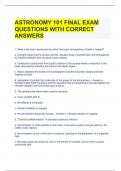
-
ASTRONOMY 101 FINAL EXAM QUESTIONS WITH CORRECT ANSWERS
- Exam (elaborations) • 42 pages • 2023
-
Available in package deal
-
- $13.59
- + learn more
ASTRONOMY 101 FINAL EXAM QUESTIONS WITH CORRECT ANSWERS 1. What is the main mechanism by which the lower atmosphere of Earth is heated? a. Sunlight heats Earth's surface and the resultant heat is transferred to the atmosphere by infrared radiation and convective gas motions. b. Conduction carries heat from Earth's interior to the surface where conduction in the lower atmosphere transfers this heat to the higher layers. c. friction between the winds in the atmosphere and the mounta...
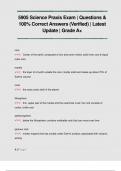
-
5905 Science Praxis Exam | Questions & 100% Correct Answers (Verified) | Latest Update | Grade A+
- Exam (elaborations) • 29 pages • 2024
- Available in package deal
-
- $13.49
- + learn more
core : Center of the earth; composed of iron and some nickel; solid inner core & liquid outer core mantle : the layer of of earth outside the core; mostly solid and makes up about 70% of Earth's volume crust : the rocky outer shell of the planet lithosphere : thin, upper part of the mantle and the outermost crust; the rock consists of cooler, brittle rock asthenosphere : below the lithosphere; contains malleable rock that can move over time igneous rock : molten magma that has ...
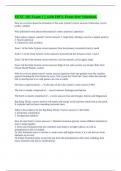
-
EESC 101 Exam 1 || with 100% Error-free Solutions.
- Exam (elaborations) • 9 pages • 2024
-
Available in package deal
-
- $11.29
- + learn more
How do we know about the formation of the solar system? correct answers Telescopes, rovers, probes, samples Who published work about heliocentrism? correct answers Copernicus What makes a planet a planet? correct answers 1. large body orbiting a star (in a regular pattern) 2. Nearly spherical 3. Cleared it's orbit of debris Zone 1 of the Solar System correct answers First four planets, terrestrial (rocky), small Zone 1.5 of the Solar System correct answers Asteroid belt lies betwe...
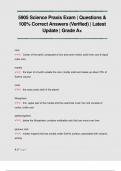
-
5905 Science Praxis Exam | Questions & 100% Correct Answers (Verified) | Latest Update | Grade A+
- Exam (elaborations) • 29 pages • 2024
- Available in package deal
-
- $13.49
- + learn more
core : Center of the earth; composed of iron and some nickel; solid inner core & liquid outer core mantle : the layer of of earth outside the core; mostly solid and makes up about 70% of Earth's volume crust : the rocky outer shell of the planet lithosphere : thin, upper part of the mantle and the outermost crust; the rock consists of cooler, brittle rock asthenosphere : below the lithosphere; contains malleable rock that can move over time igneous rock : molten magma that has ...
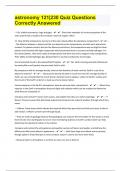
-
astronomy 121|230 Quiz Questions Correctly Answered|27 Pages
- Exam (elaborations) • 27 pages • 2024
-
- $9.49
- + learn more
-- Life, orbital resonances, rings and gaps. - ️️Give three examples of current properties of the solar system that a model of its formation need not explain. Why? 11. How did the temperature structure of the solar nebula affect the planetary composition? - ️️-- The distance between a planet and the sun determines the temperatures at which each planet was created. For planets close to the Sun like Mercury and Venus, the temperature was too high for those planets to be formed with light ...
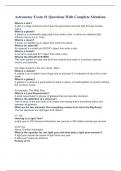
-
Astronomy Exam #1 Questions With Complete Solutions.
- Exam (elaborations) • 10 pages • 2023
-
- $13.49
- + learn more
Astronomy Exam #1 Questions With Complete Solutions. What is a star? A star is a large luminous ball of gas that generates heat and light through nuclear fusion. What is a planet? A planet is a moderately large object that orbits a star. It shines by reflected light. Planets may be icy or rocky What is a moon? A moon (or satellite) is an object that orbits the planet. What is an asteroid? An asteroid is a small and ROCKY object that orbits a star. What is a comet? A comet is small a...
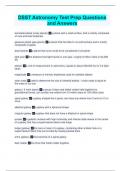
-
DSST Astronomy Test Prep Questions and Answers
- Exam (elaborations) • 6 pages • 2024
-
Available in package deal
-
- $10.49
- + learn more
terrestrial planet (rocky planet) a planet with a solid surface, that is mainly composed of rock and solid materials gaseous planet (gas giants) a planet that has little to no solid surface and is mostly composed of gases dwarf planet a planet that is too small to be considered a full planet light-year the distance that light travels in one year, roughly 6 trillion miles or 63,000 AU parsec a unit of measurement in astronomy, equals to about 206,000 AU or 3.2 light-years magnitude...

Study stress? For sellers on Stuvia, these are actually golden times. KA-CHING! Earn from your study resources too and start uploading now. Discover all about earning on Stuvia


